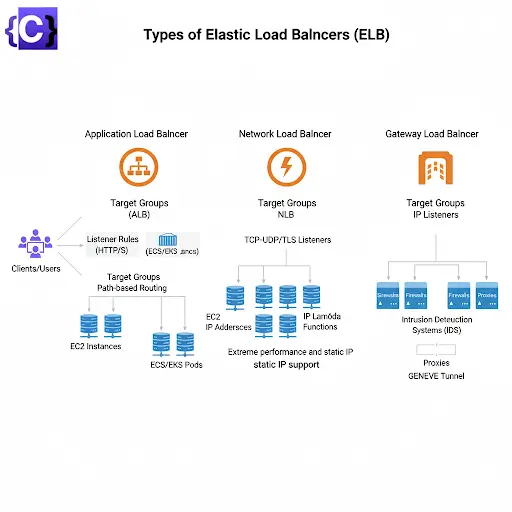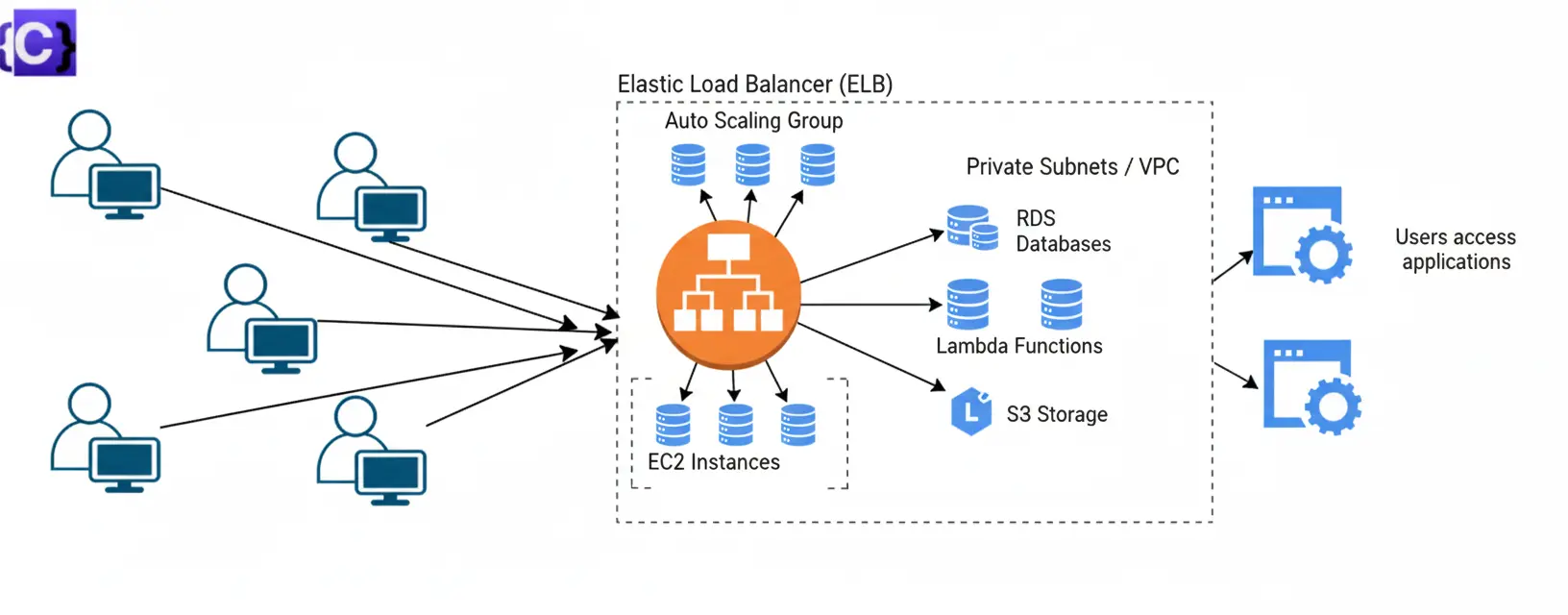The Elastic Load Balancer is a service provided by Amazon in which the incoming traffic is efficiently and automatically distributed across a group of backend servers in a manner that increases speed and performance. It helps to improve the scalability of your application and secures your applications. Load Balancer allows you to configure health checks for the registered targets. In case any of the registered targets (Autoscaling group) fails the health check, the load balancer will not route traffic to that unhealthy target. Thereby ensuring your application is highly available and fault tolerant. To know more about load balancing refer to Load Balancing in Cloud Computing.
Key Components
- Load Balancer The ELB itself, which accepts incoming traffic and routes it to the registered targets.
- Target Group A logical grouping of targets, such as EC2 instances, and a protocol and port to route traffic to.
- Target Resources, such as EC2 instances or IP addresses, that receive traffic from the load balancer.
- Listener A process that checks for connection requests from clients and forwards them to one or more targets.
- Availability Zones (AZs) Data centers with redundant power, networking, and cooling.
Elastic Load Balancer Types
Now let us understand the different types of ELB provided by AWS

1. Application Load Balancer (ALB)
The Application Load Balancer (ALB) operates at the application layer, also known as Layer 7 of the OSI model. It is designed for intelligent request routing and is ideal for modern web applications, microservices, and containerized workloads. An ALB can route HTTP and HTTPS traffic based on factors such as URL paths, host headers, or query string parameters. For example, requests for /api can be routed to one service, while /images can be routed to another, providing advanced flexibility for web applications.
ALBs deeply integrate with AWS WAF (Web Application Firewall), AWS Shield, and AWS Certificate Manager (ACM), adding robust security and SSL/TLS management. They also support WebSocket and HTTP/2 protocols, which enable real-time communication and improved website performance.
Benefits of Application Load Balancer:
- Content-based intelligent routing (path-based, host-based).
- Optimized for modern apps, microservices, and containers.
- Built-in security with WAF, Shield, and ACM integration.
- Supports WebSocket and HTTP/2 for real-time communication.
- Highly available and scalable for delivering faster websites.
2. Network Load Balancer (NLB)
The Network Load Balancer (NLB) operates at the transport layer (Layer 4) and is built for extreme performance. It can handle millions of requests per second with ultra-low latency, making it perfect for workloads requiring high-speed packet processing. Unlike ALBs, NLBs are not content-aware; instead, they forward traffic based on IP protocol data such as TCP, UDP, and TLS.
One of the biggest advantages of NLB is that it preserves the client’s IP address, which is critical for compliance, logging, and monitoring. NLB also integrates seamlessly with AWS Global Accelerator, allowing organizations to achieve cross-region load balancing with enhanced performance and availability. It is particularly well-suited for gaming applications, IoT devices, and financial systems where speed and reliability are essential.
Benefits of Network Load Balancer:
- Handles millions of requests per second with ultra-low latency.
- Supports TCP, UDP, and TLS protocols for diverse workloads.
- Preserves client IP for logging and compliance.
- Seamless integration with AWS Global Accelerator for global reach.
- Best choice for real-time, high-performance applications.
3. Gateway Load Balancer (GWLB)
The Gateway Load Balancer (GWLB) is a powerful solution for deploying and scaling third-party virtual appliances such as firewalls, intrusion detection/prevention systems (IDS/IPS), and deep packet inspection (DPI) tools. It operates at Layer 3 and uses the GENEVE protocol for efficient traffic encapsulation.
By acting as a transparent network gateway, GWLB allows enterprises to insert security appliances directly into the data path without complicating network design. For example, incoming traffic can be routed to multiple firewall instances through a GWLB, ensuring high availability and security at scale. This reduces operational overhead while maintaining strong compliance and security standards.
Benefits of Gateway Load Balancer:
- Simplifies deployment of firewalls, IDS/IPS, and DPI tools.
- Operates at Layer 3 with GENEVE protocol for efficient traffic flow.
- Provides scalability and high availability for security appliances.
- Ideal for organizations with strict compliance and monitoring needs.
- Reduces operational complexity with a centralized gateway.
4. Classic Load Balancer (CLB)
The Classic Load Balancer (CLB) is the original AWS load balancer, operating at both the application layer (Layer 7) and the transport layer (Layer 4). Unlike modern load balancers that use target groups, the CLB directly registers instances with the load balancer itself.
While the Classic Load Balancer offers basic load balancing features, it is best suited for legacy applications running in the older EC2-Classic network. AWS now recommends using ALB, NLB, or GWLB for new applications since they provide more advanced features and integrations. However, CLBs remain in use for workloads that require backward compatibility and do not need the complexity of modern routing or scaling features.
Benefits of Classic Load Balancer:
Cost-effective for applications with basic requirements.
Simple setup and basic load balancing for legacy applications.
Supports both Layer 4 and Layer 7 traffic.
Provides backward compatibility for older AWS workloads.
AWS Elastic Load Balancer Types – Comparison Table
| Load Balancer Type | OSI Layer | Best For / When to Use | Key Benefits |
|---|---|---|---|
| Application Load Balancer (ALB) | Layer 7 (Application) | Use when you need intelligent routing based on URL paths, host headers, or query strings. Ideal for modern web apps, microservices, and containerized workloads (ECS/EKS). | Content-based routing, integration with WAF & Shield, supports WebSocket/HTTP/2, highly scalable and secure. |
| Network Load Balancer (NLB) | Layer 4 (Transport) | Use when applications require ultra-low latency and can handle millions of requests per second. Ideal for gaming, IoT, financial apps, and real-time systems. | High performance, supports TCP/UDP/TLS, preserves client IP, integrates with Global Accelerator, extremely scalable. |
| Gateway Load Balancer (GWLB) | Layer 3 (Network) | Use when you need to deploy, scale, and manage security appliances like firewalls, IDS/IPS, or deep packet inspection tools. Perfect for enterprises with strong compliance/security needs. | Simplifies security tool deployment, scales third-party appliances, provides centralized traffic inspection, uses GENEVE protocol for efficiency. |
| Classic Load Balancer (CLB) | Layer 4 & 7 | Use for legacy applications that run in the EC2-Classic network or when backward compatibility is needed. Not recommended for new workloads. | Basic load balancing, simple setup, cost-effective, supports both Layer 4 and Layer 7 traffic. |
Advantages of Elastic Load Balancer
- ELB automatically distributes incoming application traffic across multiple targets, such as EC2 instances, containers, and IP addresses, to achieve high availability.
- It can automatically scale to handle changes in traffic demand, allowing you to maintain consistent application performance.
- It can monitor the health of its registered targets and route traffic only to the healthy targets.
- It evenly distributes traffic across all availability zones in a region, improving fault tolerance.
Disadvantages of Elastic Load Balancer
- ELB can add latency to your application, as traffic must pass through the load balancer before being routed to your targets.
- It has limited customization options, so you may need to use additional tools and services to fully meet your application’s requirements.
- It can introduce additional complexity to your application architecture, requiring you to manage and maintain additional resources.
- It can increase your overall AWS costs, especially if you have high traffic volumes or require multiple load balancers.
Conclusion
Elastic Load Balancing (ELB) is one of the core services in AWS that ensures applications remain highly available, fault-tolerant, and scalable. By intelligently distributing incoming traffic across multiple targets, ELB eliminates single points of failure and allows organizations to seamlessly handle traffic surges without impacting performance. With four distinct types of load balancers—Application Load Balancer (ALB), Network Load Balancer (NLB), Gateway Load Balancer (GWLB), and Classic Load Balancer (CLB)—AWS gives businesses the flexibility to choose the right solution based on their application needs, security requirements, and performance goals.
The Application Load Balancer is the best choice for modern web applications and microservices, offering intelligent routing, deep AWS integrations, and protocol support like HTTP/2 and WebSockets. The Network Load Balancer is built for high-performance workloads, handling millions of requests per second at ultra-low latency, making it perfect for gaming, IoT, and financial trading platforms. The Gateway Load Balancer plays a specialized role by simplifying the deployment of third-party security appliances, ensuring compliance and centralized security management. Meanwhile, the Classic Load Balancer, though legacy, still provides value for organizations with older workloads that require backward compatibility in the EC2-Classic network.
In today’s cloud-first world, where scalability and security are critical, ELB enables organizations to design architectures that adapt to changing workloads, maintain resilience against failures, and deliver optimal user experiences. Whether the requirement is content-aware routing, low-latency network traffic handling, enterprise-grade security inspection, or basic legacy support, AWS ELB offers a tailored solution. By leveraging the right load balancer type, businesses can improve application performance, reduce downtime, and align with best practices for cloud-native architectures.
Ultimately, ELB is not just about distributing traffic—it is about creating a foundation for reliable, secure, and scalable applications in AWS. Choosing the right type of ELB is a strategic decision that directly impacts application availability, cost efficiency, and customer satisfaction
Would you like to read route53 service too


